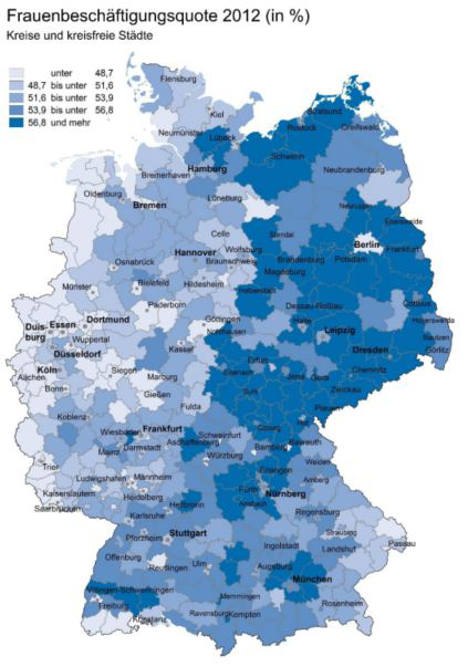More women work in east than west: Study

A higher proportion of women work in the former eastern states than in the western states, a new survey showed on Wednesday, and experts say it has everything to do with Germany's divided history.
A quarter century after the fall of the Berlin Wall, the Bertelsmann Foundation updated its information about the number of women in the work force by state. In the former East, 57.9 percent of women held permanent jobs in 2012, whereas only 50.9 percent of women in western states were in permanent employment.
The previous data, from 2007, showed that 50.9 percent of women in the east held permanent employment compared with 45.8 percent of women in the western states.
"In West Germany, women leave the job market when they have a child. There's no question of that for women from the former East," said Barbara Riedmüller, a professor at the Free University (FU) in Berlin whose research focuses on society and employment.
Riedmüller said the cultural difference between East and West would ensure a gap between the numbers of working women for years to come.
"For me, it was never a decision if I was going to work or not. At the most, it was a matter if I would work full- or part-time," said a 32-year-old Berlin journalist. The mother of two was born in the German Democratic Republic (GDR).
Nationwide, the employment rate for women is 51.8 percent, still well behind that of men in Germany at 59.2 percent.
"In the former East, roles of men and women were long considered equal – meaning both sexes worked. In the west, the dual-income-earner model for couples is less common. There, usually the man is the bread-winner," said Bertelsmann Foundation researcher Kirsten Witte.
Riedmüller said the west lags behind because of its historical adherence to the idea that women are either working or mothers and traditionally not both.
"Look at France. There, no woman comes to the conclusion to not work. And it was like that also in GDR. It had the highest divorce rate in the world, many couples lived together but didn't get married and so a good education, a permanent job and financial security for women in the states of East Germany has always been very important," Riedmüller said.

On the map, darker blue areas have more women in employment.
Women in Saxony were most likely to have permanent employment (58.5 percent), while only 47.5 percent of women in North Rhine-Westphalia and 47.2 percent of women in Saarland hold permanent employment.
Despite the fact that more women are in political spheres in the western states, this hasn't yet translated to more women in the workplace.
"Marrying family and career must be pursued by women in the west and men there must be more integrated (in the home)," Riedmüller said.
For the study, researchers looked at 295 rural districts and 106 urban districts to reach their conclusions. Numbers from the federal employment agency from last year confirmed what researchers found, though differ slightly since they are derived from the 2011 census.
SEE ALSO: Women executive quota coming in 2016
Comments
See Also
A quarter century after the fall of the Berlin Wall, the Bertelsmann Foundation updated its information about the number of women in the work force by state. In the former East, 57.9 percent of women held permanent jobs in 2012, whereas only 50.9 percent of women in western states were in permanent employment.
The previous data, from 2007, showed that 50.9 percent of women in the east held permanent employment compared with 45.8 percent of women in the western states.
"In West Germany, women leave the job market when they have a child. There's no question of that for women from the former East," said Barbara Riedmüller, a professor at the Free University (FU) in Berlin whose research focuses on society and employment.
Riedmüller said the cultural difference between East and West would ensure a gap between the numbers of working women for years to come.
"For me, it was never a decision if I was going to work or not. At the most, it was a matter if I would work full- or part-time," said a 32-year-old Berlin journalist. The mother of two was born in the German Democratic Republic (GDR).
Nationwide, the employment rate for women is 51.8 percent, still well behind that of men in Germany at 59.2 percent.
"In the former East, roles of men and women were long considered equal – meaning both sexes worked. In the west, the dual-income-earner model for couples is less common. There, usually the man is the bread-winner," said Bertelsmann Foundation researcher Kirsten Witte.
Riedmüller said the west lags behind because of its historical adherence to the idea that women are either working or mothers and traditionally not both.
"Look at France. There, no woman comes to the conclusion to not work. And it was like that also in GDR. It had the highest divorce rate in the world, many couples lived together but didn't get married and so a good education, a permanent job and financial security for women in the states of East Germany has always been very important," Riedmüller said.
On the map, darker blue areas have more women in employment.
Women in Saxony were most likely to have permanent employment (58.5 percent), while only 47.5 percent of women in North Rhine-Westphalia and 47.2 percent of women in Saarland hold permanent employment.
Despite the fact that more women are in political spheres in the western states, this hasn't yet translated to more women in the workplace.
"Marrying family and career must be pursued by women in the west and men there must be more integrated (in the home)," Riedmüller said.
For the study, researchers looked at 295 rural districts and 106 urban districts to reach their conclusions. Numbers from the federal employment agency from last year confirmed what researchers found, though differ slightly since they are derived from the 2011 census.
SEE ALSO: Women executive quota coming in 2016
Join the conversation in our comments section below. Share your own views and experience and if you have a question or suggestion for our journalists then email us at [email protected].
Please keep comments civil, constructive and on topic – and make sure to read our terms of use before getting involved.
Please log in here to leave a comment.